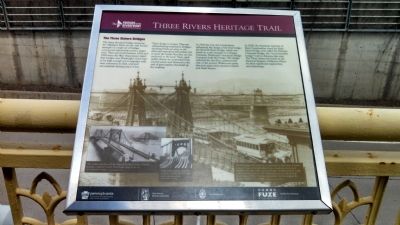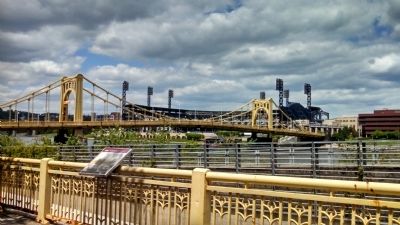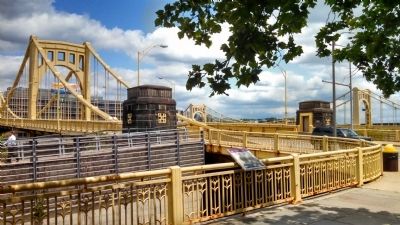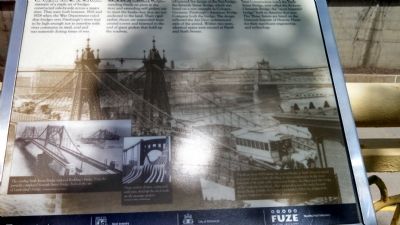Downtown in Pittsburgh in Allegheny County, Pennsylvania — The American Northeast (Mid-Atlantic)
The Three Sisters Bridges
Three Rivers Heritage Trail
The three identical bridges spanning the Allegheny River are the only known example of a triple set of bridges constructed side-by-side across a major river. They were built between 1926 and 1928 when the War Department ruled that bridges over Pittsburgh's rivers had to be high enough not to interfere with river commerce in steel, coal and war materials during times of war.
Their design is unique. They are self-anchoring suspension bridges-standing firmly on piers in the river and extending stiff girders out to meet the banks-but they are not anchored to the land. Their rigid eyebar chains are suspended from central towers and fastened to the end of giant girders that hold up the roadway.
In 1926 the City Art Commission influenced the design of the first bridge, the Seventh Street Bridge, which was based on a rare example in Cologne, Germany. Pittsburgh's American Bridge Company built the bridge. The design reflected the Art Deco architectural style of the period. Within two years, identical spans were erected at Ninth and Sixth Streets.
In 1928, The American Institute of Steel Construction voted the Sixth Street Bridge, now called the Roberto Clemente Bridge, the "most beautiful bridge" built in America that year. The Three Sisters are listed on the National Register of Historic Places for their significant engineering and technology.
Erected by Friends of the Riverfront, Pennsylvania DCNR, Steel Industry Heritage Corporation, City of Pittsburgh, FUZE.
Topics and series. This historical marker is listed in these topic lists: Architecture • Bridges & Viaducts • Industry & Commerce • Waterways & Vessels. In addition, it is included in the Art Deco series list. A significant historical year for this entry is 1926.
Location. 40° 26.683′ N, 80° 0.075′ W. Marker is in Pittsburgh, Pennsylvania, in Allegheny County. It is in Downtown. Marker can be reached from the intersection of Fort Duquesne Boulevard and 7th Street. Sign is mounted to the railing in Fort Duquesne Boulevard Park. Touch for map. Marker is in this post office area: Pittsburgh PA 15222, United States of America. Touch for directions.
Other nearby markers. At least 8 other markers are within walking distance of this marker. Seventh Street Bridge (within shouting distance of this marker); Aria Cultural District Lofts (about 300 feet away, measured in a direct line); Roberto Clemente Bridge (about 500 feet away); The Pittsburgh Agreement (about 600 feet away); Ninth Street Bridge (about 700 feet away); Sisters of Mercy (about 700 feet away); The Benedum Center (about 800 feet away); Heinz Hall (approx. 0.2 miles away). Touch for a list and map of all markers in Pittsburgh.
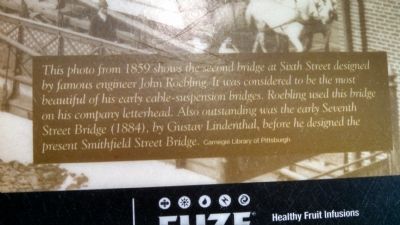
Photographed By Mike Wintermantel, June 5, 2014
5. The Three Sisters Bridges Marker
Graphic caption:
This photo from 1859 shows the second bridge at Sixth Street designed by famous engineer John Roebling. It was considered to be the most beautiful of his early cable-suspension bridges. Roebling used this bridge on his company letterhead. Also outstanding was the early Seventh Street Bridge (1884), by Gustav Lindenthal, before he designed the present Smithfield Street Bridge.
Carnegie Library of Pittsburgh
This photo from 1859 shows the second bridge at Sixth Street designed by famous engineer John Roebling. It was considered to be the most beautiful of his early cable-suspension bridges. Roebling used this bridge on his company letterhead. Also outstanding was the early Seventh Street Bridge (1884), by Gustav Lindenthal, before he designed the present Smithfield Street Bridge.
Carnegie Library of Pittsburgh
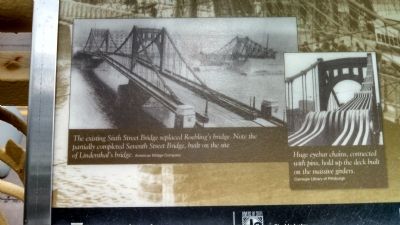
Photographed By Mike Wintermantel, June 5, 2014
6. The Three Sisters Bridges Marker
Left photo:
The existing Sixth Street Bridge replaced Roebling's bridge. Note the partially completed Seventh Street Bridge, built on the site of Lindenthal's bridge.
American Bridge Company
Right photo:
Huge eyebar chains, connected with pins, hold up the deck built on the massive girders.
Carnegie Library of Pittsburgh
The existing Sixth Street Bridge replaced Roebling's bridge. Note the partially completed Seventh Street Bridge, built on the site of Lindenthal's bridge.
American Bridge Company
Right photo:
Huge eyebar chains, connected with pins, hold up the deck built on the massive girders.
Carnegie Library of Pittsburgh
Credits. This page was last revised on February 2, 2023. It was originally submitted on June 5, 2014, by Mike Wintermantel of Pittsburgh, Pennsylvania. This page has been viewed 836 times since then and 115 times this year. Photos: 1, 2, 3, 4, 5, 6. submitted on June 5, 2014, by Mike Wintermantel of Pittsburgh, Pennsylvania.
